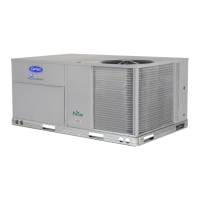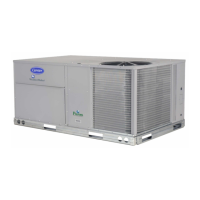122
3. If the CSB is always detecting current, then verify that the
compressor is on. If the compressor is ON, check the con-
tactor and the relay on the MBB or CXB. If the compres-
sor is OFF and there is no current, verify the CSB wiring
and replace if necessary.
4. Return to Normal mode and observe compressor operation
to verify that compressor current sensor is working and
condenser fans are energized.
A051 (Circuit A, Compressor 1 Stuck On Failure)
A052 (Circuit A, Compressor 2 Stuck On Failure)
A053 (Circuit A, Compressor 3 Stuck On Failure)
A054 (Circuit B, Compressor 1 Stuck On Failure)
A055 (Circuit B, Compressor 2 Stuck On Failure)
A056 (Circuit B, Compressor 3 Stuck On Failure)
If the current sensor board reads ON while the compressor re-
lay has been commanded OFF for a period of 4 continuous sec-
onds, an alarm is generated and the HVAC Mode will display
Compressor Stuck On. These alarms are only monitored for a
period of 10 seconds after the compressor relay has been com-
manded OFF. This is done to facilitate a service technician
forcing a relay to test a compressor.
When the HVAC Mode indicates a compressor stuck on condi-
tion, the following will occur:
1. The outdoor fans will continue to control head pressure.
2. The supply fan will remain on.
3. Heating will be disabled.
A manual reset or power reset of the unit is required for these
alarms.
The possible causes are:
• Compressor contactor has failed closed.
• Relay output on MBB or CXB that drives compressor con-
tactor has failed closed.
• Failed CSB or wiring error.
To check out alerts A051, A052, A053, A054, A055, A056:
1. Place the unit in Service Test mode. All compressors
should be OFF.
2. Check for welded compressor contactor.
3. Verify there is not 24 vac across the contactor coil of the
compressor in question. If 24 vac is measured across coil,
check relay on MBB or CXB and associated wiring.
4. Verify CSB wiring.
5. Return to Normal mode and observe compressor operation
to verify that compressor current sensor is working and
condenser fans are energized after compressor starts.
T057 (Circuit A, High Pressure Switch Failure Alert)
T058 (Circuit B, High Pressure Switch Failure Alert)
A057 (Circuit A, High Pressure Switch Failure Alarm)
A058 (Circuit B, High Pressure Switch Failure Alarm)
The high pressure switch for each circuit is wired in series with
the compressor contactor coils of each compressor on the cir-
cuit to disable compressor operation immediately upon a high
discharge pressure condition. The normally closed contacts in
the switches are calibrated to open at 650 ± 10 psig which cor-
responds to a saturated condensing temperature of 155.6
±1.3°F. The pressure switches will automatically reset when
the discharge pressure is reduced to 500 ± 15 psig which corre-
sponds to a saturated condensing temperature of 134.1 ± 2.4°F.
The output of each high pressure switch is wired to inputs on the
RXB to provide the control with an indication of a high pressure
switch trip. This alarm could occur when compressors are off if
the wiring to the switch is broken or the switch has failed open.
If the high pressure switch trips on a circuit with compressors
commanded on, the discharge pressure is recorded. If the recorded
discharge pressure is between 630 to 660 psig (saturated condens-
ing temperature between 153.0 and 156.9°F), and is also less than
the value recorded on any previous high pressure switch trip, the
upper horizontal portion of the compressor operating envelope
(see Fig. 18) is lowered 0.4°F (3 psig). The control will not allow
the compressor operating envelope to be lowered below 153.0°F
(630 psig).
This is done to make a rough calibration of the high pressure
switch trip point. In most cases this allows the control to detect
a high head pressure condition prior to reaching the high pres-
sure switch trip point.
When the trip occurs, all mechanical cooling on the circuit is
shut down until the HPS is cleared for 15 minutes. Any time
this alert occurs, a HPS trip strike will be logged on the affect-
ed circuit. The alert is issued on HPS trip strikes 1 and 2, and
an alarm (A057, A058) is issued on strike 3.
An active alert or alarm will always cause the circuit to be shut
down. After 15 minutes, the circuit is allowed to restart if there
are fewer than 3 strikes on the affected circuit. If three succes-
sive strikes occur the circuit will be locked out, requiring a
manual reset or power reset of the unit. The clearing of HPS
trip strikes during compressor operation is achieved through
5 continuous minutes of run time on the affected circuit. So, if
there are one or two strikes on the circuit and a compressor on
the circuit turns on and runs for 5 minutes straight with no fail-
ure, the circuit's HPS trip strikes are cleared.
NOTE: This alert/alarm is broadcast to the network.
T068 (Circuit A Return Gas Thermistor Failure)
This alarm trips during a thermistor failure of the return gas
temperature sensor. It is used with MLV option only.
T072 (Evaporator Discharge Reset Sensor Failure)
This sensor is responsible for third party reset of the cooling sup-
ply air set point. If the unit is configured for “third party reset”
(Configuration
EDT.R
RS.CF=3) and this alert occurs, no
reset will be applied to the cooling supply air set point. Recovery
from this alert is automatic. Reason for error is either a faulty
sensor, wiring error, or damaged input on the CEM board.
T073 (Outside Air Temperature Thermistor Failure)
Failure of this thermistor (Temperatures
AIR.T
OAT) will
disable any elements of the control which requires its use.
Economizer control beyond the vent position and the calcula-
tion of mixed air temperature for the SumZ algorithm will not
be possible. Recovery from this alert is automatic. Reason for
error is either a faulty thermistor, wiring error, or damaged in-
put on the MBB control board.
T074 (Space Temperature Thermistor Failure
Failure of this thermistor (Tempera tures
AIR.T
SPT) will
disable any elements of the control which requires its use. If the
unit is configured for SPT 2 stage or SPT multi-stage operation
and the sensor fails, no cooling or heating mode may be chosen.
Recovery from this alert is automatic. Reason for error is either a
faulty thermistor in the T55, T56 or T58 device, wiring error, or
damaged input on the MBB control board.
T075 (Return Air Thermistor Failure)
Failure of this thermistor (Temperatures
AIR.T
RAT) will
disable any elements of the control which requires its use. Ele-
ments of failure include:
• the calculation of mixed air temperature for sumZ control
• the selection of a mode for VAV units
• economizer differential enthalpy or dry bulb control
• RAT offset control for dehumidification
• return air temperature supply air reset
• fan tracking for building pressure control.
Recovery from this alert is automatic. Reason for error is either
a faulty thermistor, wiring error, or damaged input on the MBB
control board.

